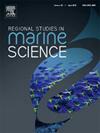A low-cost methodology for estimating beach-stranded plastic pellets using drone-based aerial photographs and marine natural wracks as proxy
IF 2.1
4区 环境科学与生态学
Q3 ECOLOGY
引用次数: 0
Abstract
We established a relationship between natural wrack debris and plastic pellet density on a sandy beach using Unmanned Aerial Vehicles (UAV), a low-cost quadcopter drone. Floating marine debris (natural or anthropogenic), including plastic pellets, tend to coalesce, drift, and strand together on sandy beaches. Drones are a cheap and widely available technology. Here, we verified whether it is plausible to indirectly estimate plastic pellet densities using drone aerial photos by identifying the local coverage of natural debris. Pellets and natural debris were manually sampled in situ on two beaches on the coast of São Paulo (Brazil) to verify the relationship between them. Once a model was established, drone aerial photos were taken on the largest beach (Itaguaré - 2 km in length), and heat maps of the distribution of natural debris from both methods were compared. The regression models from the field method predicted pellet densities with 45 % accuracy. Other factors not considered in this study (wave energy and sediment composition) may have influenced this accuracy. However, when comparing the pellet dispersion heat maps obtained from both methods (manual sampling and drone-based aerial photos), it can be conclude that the drone-based method was effective, especially in identifying hot spots for pellet entries onto beaches. The drone-based method allows a single person to evaluate the occurrence of plastic pellets in 35 thousand times more beach area than the conventional field methodology in just over 1 h of flight. This method is fast, easy, scalable, and accessible.
一种低成本的方法,用于估计海滩搁浅的塑料颗粒,使用基于无人机的航空照片和海洋自然残骸作为代理
我们利用一种低成本的四轴飞行器无人机(UAV)在沙滩上建立了自然残骸碎片和塑料颗粒密度之间的关系。漂浮的海洋垃圾(自然的或人为的),包括塑料颗粒,倾向于在沙滩上聚集、漂移和搁浅在一起。无人机是一种廉价且广泛可用的技术。在这里,我们通过确定自然碎片的局部覆盖范围,验证了使用无人机航拍照片间接估计塑料颗粒密度是否合理。在圣保罗(巴西)海岸的两个海滩上对颗粒和自然碎片进行了现场人工取样,以核实它们之间的关系。一旦建立了模型,就在最大的海滩(itaguar - 2 公里长)上拍摄无人机航拍照片,并比较两种方法的自然碎片分布热图。现场法回归模型预测球团密度的准确率为45% %。本研究未考虑的其他因素(波能和沉积物组成)可能影响了这种准确性。然而,当比较两种方法(人工采样和基于无人机的航拍照片)获得的颗粒分散热图时,可以得出结论,基于无人机的方法是有效的,特别是在识别颗粒进入海滩的热点方面。基于无人机的方法允许一个人在超过1 h的飞行时间内评估塑料颗粒在比传统现场方法多3.5万倍的海滩区域的出现情况。这种方法快速、简单、可扩展且可访问。
本文章由计算机程序翻译,如有差异,请以英文原文为准。
求助全文
约1分钟内获得全文
求助全文
来源期刊

Regional Studies in Marine Science
Agricultural and Biological Sciences-Ecology, Evolution, Behavior and Systematics
CiteScore
3.90
自引率
4.80%
发文量
336
审稿时长
69 days
期刊介绍:
REGIONAL STUDIES IN MARINE SCIENCE will publish scientifically sound papers on regional aspects of maritime and marine resources in estuaries, coastal zones, continental shelf, the seas and oceans.
 求助内容:
求助内容: 应助结果提醒方式:
应助结果提醒方式:


